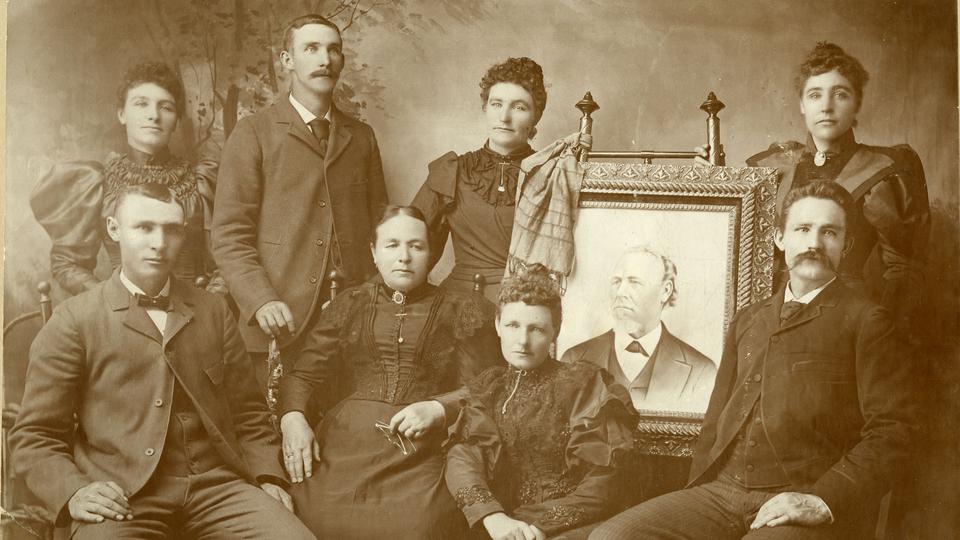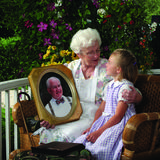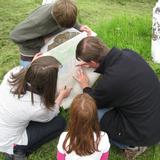“In all of us,” wrote Alex Haley, author of the popular novel Roots (based on his own family history), “there is a hunger, marrow-deep, to know our heritage — to know who we are and where we have come from.”
That “hunger” is growing throughout the world. People are discovering that to understand better who they are, they must know the stories of family members who went before them. Members of The Church of Jesus Christ of Latter-day Saints are among those who have a desire to connect in a personal way across generations by researching their family history, gathering written personal histories, preserving oral histories and recording interviews of the life experiences of elderly family members for the benefit of posterity.
| Great-grandmother tells her great-granddaughter stories about the girl's great-grandfather. 2014 by Intellectual Reserve, Inc. All rights reserved. | 1 / 3 |
Mormons believe the family is ordained of God. They also believe the family is the fundamental unit of society and central to God’s eternal plan for His children. This belief impels older members of the Church to share the important, life-changing moments of their lives with children and grandchildren who, upon hearing and preserving these experiences, develop a stronger sense of family and belonging. With the knowledge of their forbearers’ accounts of strength over adversity, children and grandchildren become better equipped to overcome difficult challenges in their own lives.
“As we contemplate what those before us have gone through that we might be here, as we sense their faith and courage and feel their love for us and our love for them, we realize what is really important,” said former Church leader Elder John H. Groberg to a worldwide conference of Latter-day Saints in 1980. “We realize that so-called problems are only what we see when we take our eye off our eternal goal.”
Latter-day Saints focus on their family history for another reason — their belief that families can be together after this life. They research names and other information so sacred ceremonies and rites can be performed in behalf of their ancestors in Latter-day Saint temples, thereby exercising faith that they will be linked to loved ones as an eternal family.
Mormon youth worldwide are becoming more involved in seeking out personal histories and stories of their family members.
“It is no coincidence that FamilySearch and other tools have come forth at a time when young people are so familiar with a wide range of information and communication technologies,” said Elder David A. Bednar, a member of the Quorum of the Twelve Apostles, one of the senior governing bodies of the Church.
Examples of such tools are the Family Tree and Memories features recently launched by FamilySearch. The new Memories feature allows users to easily upload and manage family photos online and to tell their favorite ancestor stories. With photos, faces can be identified and linked to the respective ancestors’ profiles in a user’s family tree, ensuring they will be accessible for future generations. Photos and stories can also be seamlessly shared via Facebook, Twitter, Google+, Pinterest and email.
Connecting Generations: Tools and Resources
Members of The Church of Jesus Christ of Latter-day Saints and others in communities around the world are discovering their ancestors with the help of an ever-increasing abundance of resources from the Church-sponsored FamilySearch, the largest nonprofit genealogical organization in the world.
Family History Research
Through its network of 4,715 family history centers in 132 countries, people tracing their family trees can access — for free — billions of names collected over decades from birth, marriage and death certificates, censuses, wills and other records.
FamilySearch is continuously seeking technological advances to aid in digitally preserving and making records accessible to the public online. For example, more than 250 digital record preservation camera teams are directed by FamilySearch in 45 countries to produce more than 100 million new digital images for free online use each year. FamilySearch plans to expand the number of camera teams to 500 in 2014.
FamilySearch.org’s database already allows access to over three billion family records from 110 countries.
Stories, Photos and Other Information: Preserving and Collaborating
In 2013 the organization launched its Family Tree and Memories features to help people everywhere collaborate on their family trees online and to personally preserve and share more family memories through photos and stories of their ancestors.
The new Memories feature allows users to easily upload and manage family photos online and to tell their favorite ancestor stories. With photos, faces can be identified and linked to the respective ancestors’ profiles in a user’s family tree, ensuring they will be accessible for future generations. Photos and stories can also be seamlessly shared via Facebook, Twitter, Google+, Pinterest and email.
Every user of Family Tree can upload as many as 5,000 photos (five megabyte-per-image limit), and each story can be up to 100 pages long. Family Tree also enables individuals to collaborate online to build and manage their shared family history.
At Church family history centers in North America, a recently implemented family photo scanning service allows participants to log in to their free FamilySearch account and digitally upload family photos and historic documents to an online folder. They can then leisurely connect the photos and documents to ancestors in their FamilySearch Family Tree. Patrons can also save images of the scanned documents and photos to personal flash drives.
International Links to "Generations Connect Through Personal Histories and Life Stories"




